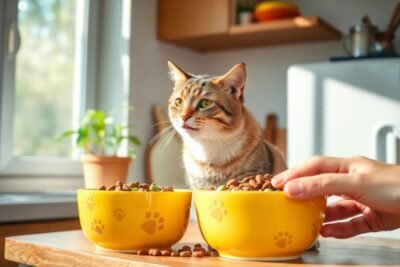
The Ultimate Guide to Diabetes-Friendly Cat Food
- Understanding Diabetes in Cats
- The Importance of Choosing the Right Cat Food
- Key Ingredients to Look For in Diabetic Cat Food
- Ingredients to Avoid in Diabetic Cat Food
- Top Tips for Transitioning Your Cat to Diabetes-Friendly Food
- Homemade Diet Options for Diabetic Cats
- Monitoring Your Cat’s Diabetes Management
- Success Stories: Diabetic Cats Who Thrived on Special Diets
- Join Our Community for Support and Resources
Understanding Diabetes in Cats
Feline diabetes mellitus is a significant health concern that affects an increasing number of cats. This condition is characterized by the body's inability to produce adequate insulin or respond effectively to it, leading to elevated blood glucose levels. Diabetes in cats is primarily categorized into two types: Type I, where the pancreas fails to produce insulin, and Type II, more common in overweight cats, where there is insulin resistance. This resistance often results from obesity and a sedentary lifestyle.
The symptoms of diabetes in cats can be subtle and may include frequent urination, increased thirst, weight loss despite a normal or increased appetite, and lethargy. Cat owners may notice their pets drinking more water and urinating more often, which can sometimes lead to confusion in the diagnosis, as these are also symptoms associated with other health issues. Additionally, untreated diabetes can lead to complications such as urinary tract infections and ketoacidosis, which can be life-threatening.
One of the most crucial aspects of managing feline diabetes is dietary control. A well-balanced, diabetes friendly cat food can help regulate blood sugar levels, maintain a healthy weight, and improve overall well-being. Foods specifically formulated for diabetic cats typically have a higher protein content and lower carbohydrate levels, which can enhance insulin sensitivity and promote weight loss in overweight cats. Adopting a specific diet tailored to their needs is not just beneficial but is essential for their health. Moreover, regular monitoring of blood glucose levels and consultation with a veterinarian are crucial in effectively managing and controlling a cat's diabetes.
The Importance of Choosing the Right Cat Food
Selecting the appropriate cat food is crucial for managing diabetes in cats, as it directly impacts their health and well-being. Diabetes-friendly cat food plays a significant role in regulating blood sugar levels and offers numerous benefits for affected felines. Diabetics cats require a diet that is specifically tailored to their unique nutritional needs, which helps maintain stable glucose levels and prevents complications related to the condition.
One of the primary dietary considerations for diabetic cats is the balance of nutrients, particularly the inclusion of high-quality protein and fiber. Protein is essential for muscle maintenance and overall energy support, while fiber aids in slowing down the absorption of glucose during digestion. Foods that are low in carbohydrates, especially simple sugars, are preferable as they help prevent spikes in blood sugar levels. Choosing cat food formulated with these dietary needs in mind ensures that your feline companion receives the appropriate nutrition without compromising their health.
Additionally, monitoring the calorie content of cat food is important. An overweight cat is more susceptible to diabetes and may experience further complications if not properly managed. Therefore, selecting diabetes-friendly cat food that has controlled calorie content not only supports weight management but also contributes to better overall health. Consult with a veterinarian when choosing the right cat food to ensure that it is specifically designed to meet your diabetic cat's nutritional requirements.
In conclusion, the selection of suitable cat food is paramount for managing diabetes in cats. By focusing on a balanced diet with adequate protein, fiber, and controlled carbohydrates, owners can significantly contribute to the well-being of their diabetic pets, ensuring a healthier and more fulfilling life.
Key Ingredients to Look For in Diabetic Cat Food
When selecting diabetes-friendly cat food for your feline companion, it is crucial to focus on the specific ingredients that will promote optimal health and blood sugar regulation. Low carbohydrate content is one of the most important factors to consider. Cats are obligate carnivores, and their natural diet consists predominantly of proteins and fats, with minimal carbohydrates. Diabetic cat foods typically have lower carbohydrate levels that can help prevent spikes in blood sugar, contributing to better glucose management.
Another critical component is high-quality proteins. Protein plays a vital role in maintaining muscle mass and overall health, especially for cats with diabetes who may be at risk of weight loss. Foods that focus on premium protein sources, such as chicken, turkey, or fish, provide essential amino acids necessary for feline health. These proteins should ideally come from identifiable animal sources rather than by-products, ensuring that your cat receives the complete nutritional profile required.
Additionally, incorporating fiber into diabetic cat food can be beneficial for creating a feeling of fullness and aiding in weight management. Fiber helps slow down the absorption of glucose, thus preventing rapid fluctuations in blood sugar levels. Ingredients like beet pulp or pumpkin can serve as excellent sources of fiber in diabetic cat food. It's important that the fiber content is balanced, as too much can lead to gastrointestinal upset.
In essence, an ideal diabetes-friendly cat food should have a lower carbohydrate content, high-quality proteins, and beneficial fiber sources. These ingredients form the foundation of a healthy diet, supporting stable blood sugar levels and helping to maintain an optimal weight for diabetic cats. By ensuring that your cat’s food contains these key components, you are taking significant steps towards managing their diabetes effectively.
Ingredients to Avoid in Diabetic Cat Food
When selecting diabetes-friendly cat food, it is crucial to be aware of certain harmful ingredients that can adversely affect a cat’s health and blood sugar regulation. One of the primary concerns is the presence of high levels of carbohydrates. Cats are obligate carnivores, which means their diet should be predominantly protein-based. Foods that contain excessive carbohydrates can lead to fluctuating blood sugar levels, posing a significant risk to diabetic felines.
Another critical ingredient to avoid is sugar or any sweeteners. Naturally occurring sugars can be found in some fruits and vegetables; however, cat food often contains added sugars that can quickly elevate a cat's blood glucose levels. It is important to look for products without ingredients such as corn syrup, sucrose, or fructose, as these can exacerbate diabetes symptoms and complicate management.
Furthermore, certain fillers and by-products should also be steered clear of when considering diabetic cat food. Ingredients like corn and wheat, which serve as fillers, can contribute to the overall carbohydrate count and are often used to reduce cost instead of providing nutritional value. These fillers can also be harder for cats to digest, potentially leading to obesity, further impacting insulin resistance.
Additionally, artificial preservatives and flavorings may pose risks, as they can lead to other health complications in cats, particularly those with pre-existing conditions. Always scrutinize the ingredient list on the packaging and choose high-quality cat food that emphasizes protein and low carbohydrates. Consultation with a veterinarian can help ensure that the selected food aligns with the specific needs of diabetic cats, promoting optimal health management.
Top Tips for Transitioning Your Cat to Diabetes-Friendly Food
Transitioning your cat to diabetes-friendly cat food is a vital process that requires careful planning and patience. Cats can be sensitive to changes in their diet, so a gradual transition is essential to ensure that they accept their new food without undue stress. Start by mixing a small amount of the diabetes-friendly cat food with your cat's current diet. This allows your cat to acclimate to the new flavors and textures without overwhelming them. As a general rule, increase the ratio of the new food progressively over a week or two, depending on your cat's response.
Monitoring your cat's behavior and health during this transition is crucial. Keep an eye on their eating habits, activity level, and any changes in their weight. A balanced diabetes-friendly diet often requires a lower carbohydrate content, thus it is necessary to observe how your cat adapts. If you notice any signs of distress, such as refusal to eat or gastrointestinal upset, consult your veterinarian for advice. They may recommend slowing down the transition or suggest alternative diabetes-friendly food options better suited for your cat's preferences.
Apart from the gradual introduction, creating a positive feeding experience can significantly influence your cat's acceptance of their new diet. Serve the new food in a clean, quiet space, away from distractions or other pets. Positive reinforcement, such as gentle encouragement or treats (that also comply with their diabetes-friendly diet) can help your cat associate the new food with a pleasant experience. Remember, patience is key; cats may take time to adjust. In conclusion, by following these strategies and remaining attentive to your cat's needs, you can facilitate a smoother transition to a diabetes-friendly diet, ultimately contributing to their health and well-being.
Homemade Diet Options for Diabetic Cats
For cat owners navigating the complexities of diabetes management, exploring homemade diet options can be a rewarding alternative to commercial cat food. Creating a diabetes-friendly cat food regimen at home allows for precise control over the ingredients, ensuring that meals are both safe and nutritious. A well-balanced diet is crucial for diabetic cats, focusing on high protein content and low carbohydrates to maintain stable blood sugar levels.
One popular option for homemade diabetes-friendly cat food includes protein sources such as chicken, turkey, or fish, which provide the essential amino acids required for your cat's health. These proteins can be supplemented with small amounts of non-starchy vegetables like zucchini or green beans, which can aid digestion while keeping carbohydrate content low. When preparing meals, it is important to avoid ingredients high in sugars and carbohydrates, such as grains and certain fruits that may elevate blood glucose levels.
In addition, incorporating healthy fats into the diet is vital. Sources such as fish oil or chicken fat not only enhance flavor but also provide necessary fatty acids. An example recipe could involve cooking shredded chicken with a handful of chopped green beans and a splash of fish oil, blended to achieve a palatable texture for your cat.
When formulating homemade meals, ensuring dietary balance is crucial. Consulting with a veterinarian or a pet nutritionist can provide guidance on the correct proportions of protein, fat, and other nutrients, tailoring the recipes specifically for the diabetic condition. Additionally, introducing new foods gradually helps avoid digestive upset.
Ultimately, homemade diets can serve as a viable alternative to conventional diabetes-friendly cat food, allowing for customization and direct control over your cat’s nutritional intake. With careful planning and appropriate ingredient choices, homemade meals can lead to improved health outcomes for diabetic cats.
Monitoring Your Cat’s Diabetes Management
Effective management of a cat’s diabetes requires a dedicated approach that includes regular monitoring and consistent veterinary check-ups. Understanding the impact of the chosen diabetes-friendly cat food on your feline's health is crucial; this entails tracking various parameters such as blood sugar levels, weight fluctuations, and overall physical condition. Maintaining a detailed log of your cat’s health indicators will enable you to identify patterns and respond proactively to any concerning changes.
Blood sugar levels are a primary focus in managing diabetes in cats. It is advisable to use a glucose meter that is designed for pets, as these devices provide accurate readings which are essential for adjusting dietary choices and insulin therapy. Aim to monitor your cat’s blood glucose at least twice a week, with more frequent checks recommended during significant changes in diet or health status. Keeping a journal of these readings will help your veterinarian make informed decisions and adjustments to the diabetes-friendly cat food regimen.
Weight management is another critical component of diabetes care in cats. Obesity can exacerbate diabetes, making it vital to ensure your cat achieves and maintains a healthy weight. Regular weigh-ins at home or during veterinary visits will allow you to observe any significant changes. In this regard, the right diabetes-friendly cat food can play a significant role, as it typically contains balanced nutrients designed to support weight loss or maintenance.
Lastly, observing your cat's overall health and behavior is equally important. Look for signs of increased thirst, frequent urination, lethargy, or appetite changes, as these may indicate that your current management plan requires adjustment. Consistently monitoring and keeping your veterinarian informed of these observations can significantly enhance your cat’s health outcomes. Therefore, through diligent tracking, timely veterinary consultations, and dietary oversight, you can optimize your cat's diabetes management and improve their quality of life.
Success Stories: Diabetic Cats Who Thrived on Special Diets
Many cat owners have discovered the life-changing benefits of transitioning their pets to a diabetes-friendly diet. These inspiring success stories showcase how making informed dietary choices can lead to remarkable improvements in the health and well-being of diabetic cats. One such story is that of Bella, a seven-year-old tabby, who was diagnosed with diabetes after her owner noticed excessive thirst and frequent urination. By switching Bella to a diet tailored for diabetic cats, including high-protein, low-carbohydrate options, her blood sugar levels stabilized significantly. Within a few months, Bella was not only more energetic but also lost the weight she needed, leading to a happier and more playful disposition.
Another heartwarming example is Max, an eight-year-old Siamese. Max's journey towards better health began when his owner, Sarah, noticed he had become lethargic and lost interest in playtime. After consulting with a veterinarian, Sarah introduced diabetes-friendly cat food into Max's diet. The change included grain-free options rich in real meat, which proved effective in maintaining optimal glucose levels. After incorporating these adjustments, Max's playful spirit returned, and he even shed some pounds, allowing him to climb and explore again. Sarah couldn't have been happier to see her beloved pet thrive.
These transformative tales highlight that effective management of feline diabetes starts with diet. Many pet owners are now turning to specialized cat food designed specifically for diabetic cats, which emphasizes nutrition that helps manage insulin levels. The feedback from these stories not only showcases the efficacy of diabetes-friendly diets but also serves as a motivational reminder that making educated dietary choices can yield positive results. As such, pet owners contemplating dietary changes for their diabetic cats can find comfort in knowing that many have walked this path with success.
Join Our Community for Support and Resources
Navigating the challenges of managing diabetes in cats can often be overwhelming for pet owners. This is why joining a community committed to sharing knowledge and experiences can prove invaluable. Our portal offers a wealth of resources where you can connect with others who are addressing similar concerns, particularly in the realm of diabetes-friendly cat food. By engaging with fellow cat owners, you can exchange tips on dietary choices, treatment options, and lifestyle adjustments that can enhance the quality of life for your diabetic feline.
In our community, you will find a variety of supportive forums and discussion groups dedicated specifically to the management of cat diabetes. These platforms allow you to ask questions, seek advice, or simply share your experiences. Understanding that you are not alone in this journey can provide emotional relief and practical solutions. Additionally, our expert-curated articles and guides will deliver up-to-date information on various aspects of diabetes care, including selecting appropriate diabetes-friendly cat food and understanding your pet's unique dietary needs.
Moreover, participating in our community grants you access to local events, webinars, and workshops designed to deepen your understanding of feline diabetes management. These gatherings foster a sense of camaraderie as pet owners unite in their mission to improve their pets' health through the right nutritional choices. The knowledge shared and bonds formed in our community can empower you to make informed decisions regarding diabetic cat care.
We encourage you to join us on this journey. Together, we can navigate the complexities of diabetes management and ensure our beloved cats lead healthier lives. By connecting with others in the community, you will find encouragement, insight, and the shared reassurance of being part of a compassionate network.





